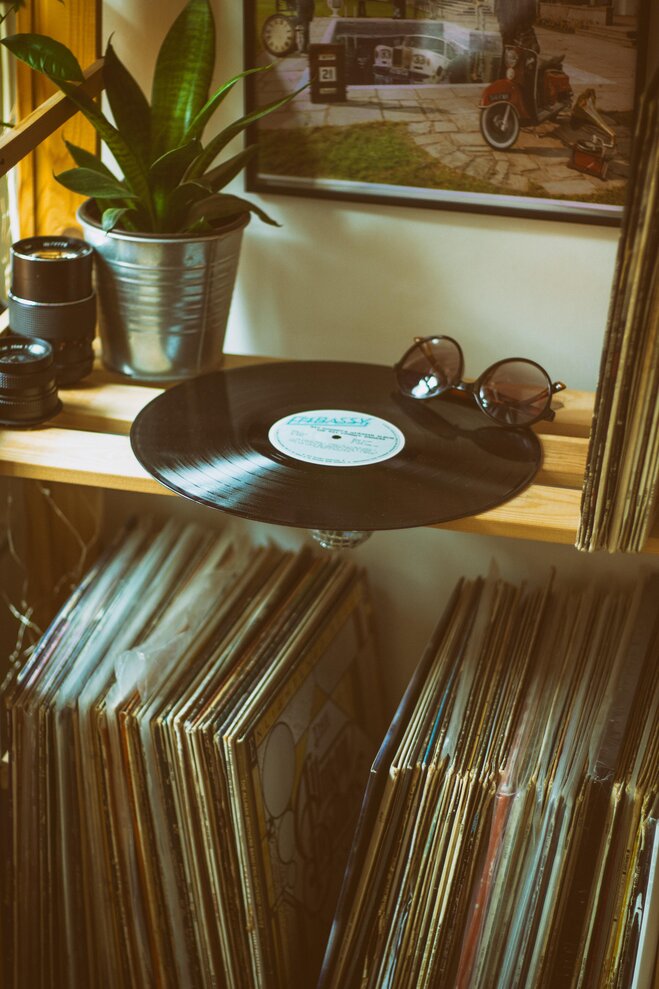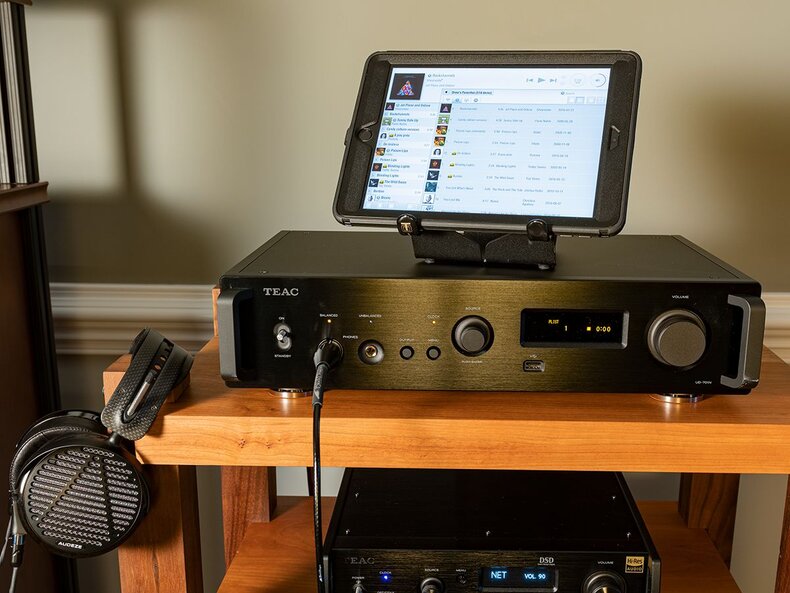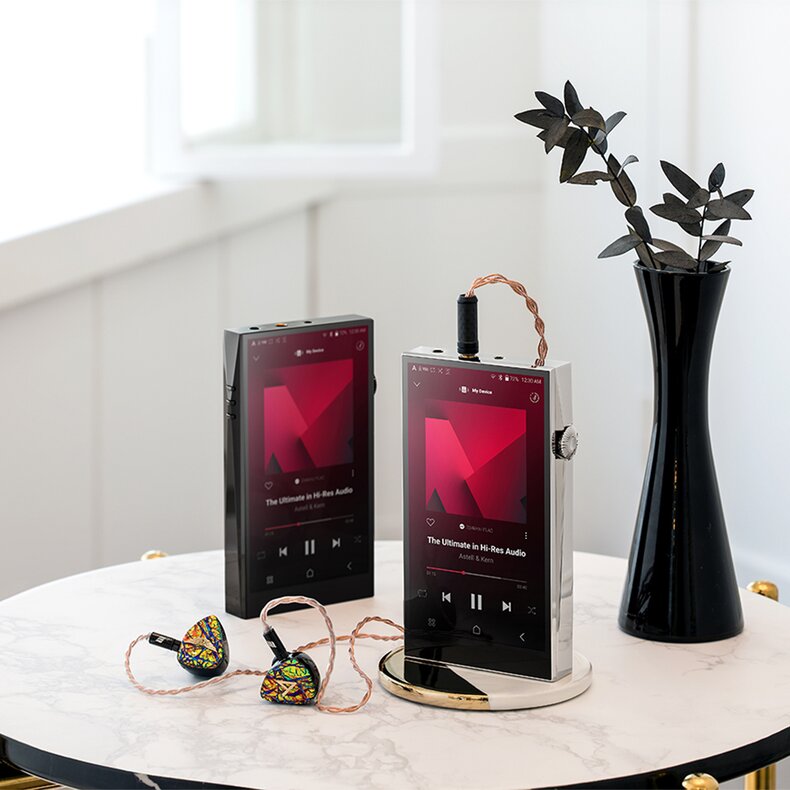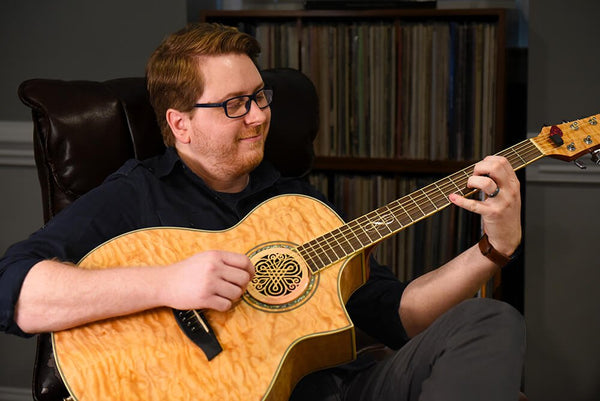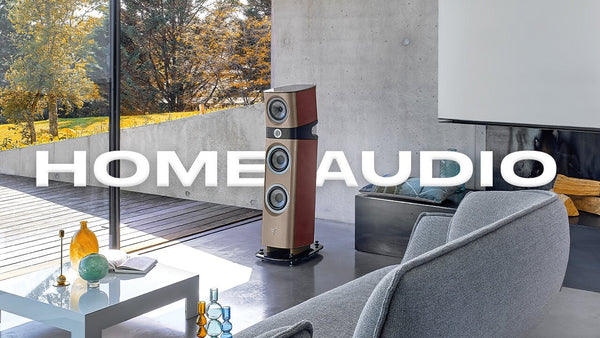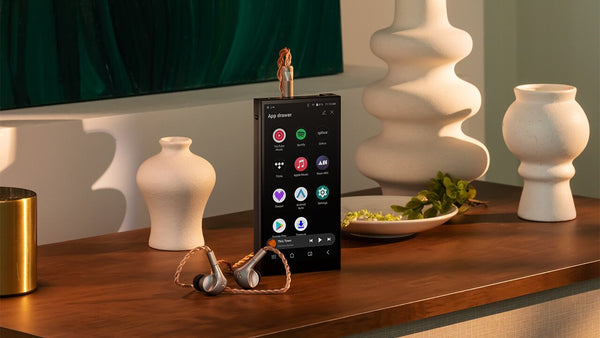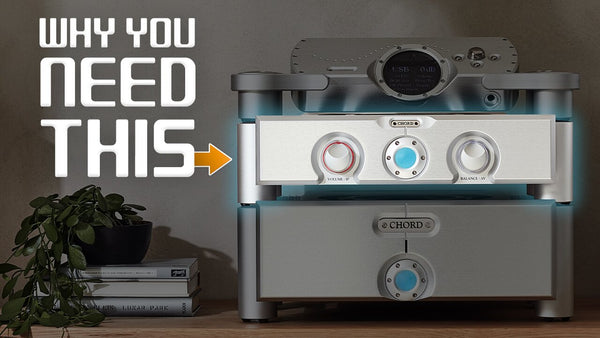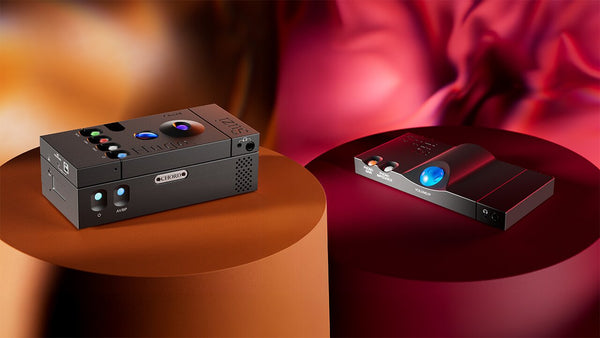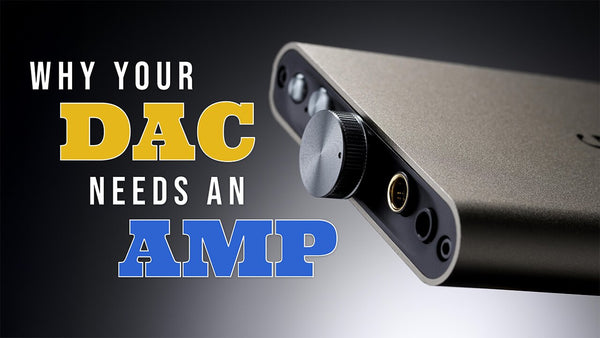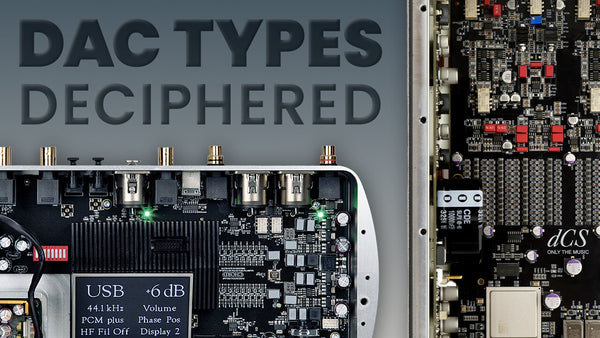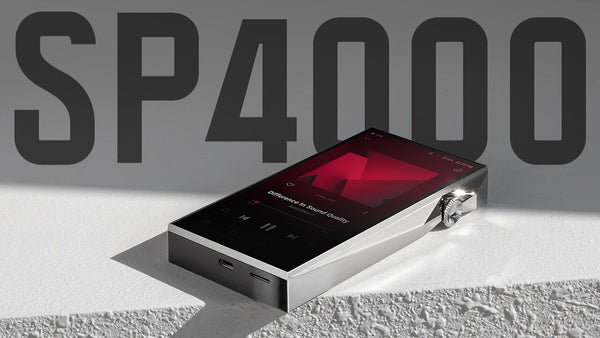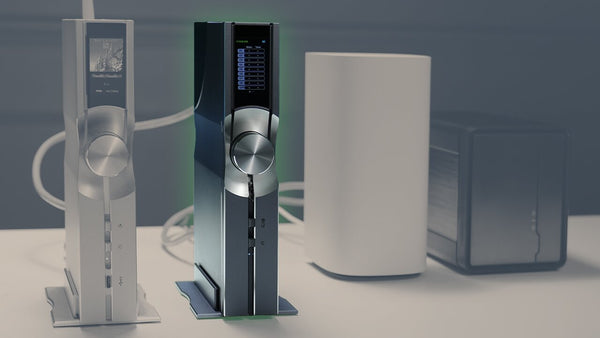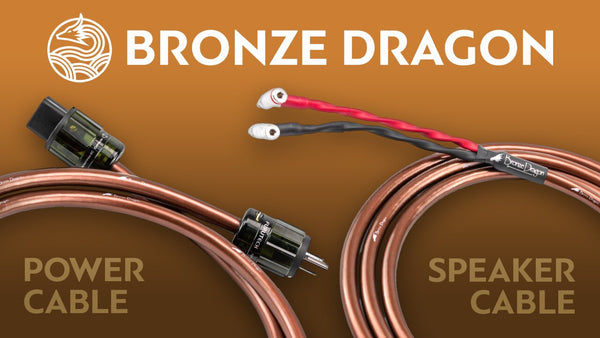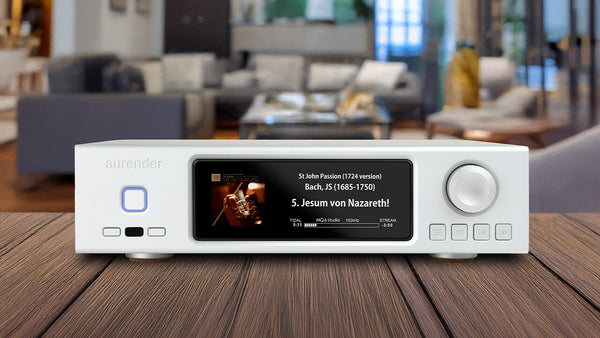What is a DAC & Why You Need One for Optimal Sound Quality

Everything You Need to Know About Converting Digital to Analog & Why It Matters
In the realm of high-fidelity sound systems, one essential piece of technology stands tall: the Digital-to-Analog Converter, or DAC for short. For many audiophiles, the DAC is like the wizard behind the curtain, transforming digital signals from our devices into the beautiful analog sound waves that our ears can appreciate. Imagine this: when we listen to music on our smartphones, computers, or even streaming services, the music is stored and transmitted in digital form. However, our ears don't understand these digital 0s and 1s; they crave the warm, rich tones of analog audio. This is where the DAC steps in, converting those digital signals into analog sound that faithfully reproduces the original recording. In essence, the DAC is the bridge between our digital music libraries and the captivating, lifelike sound that audiophiles crave from their Hi-Fi systems. It's the secret ingredient that elevates the listening experience from ordinary to extraordinary, allowing us to immerse ourselves fully in the intricate details and nuances of our favorite music. So, whether you're a seasoned audiophile or new to the world of high-fidelity sound, understanding the role of the DAC is crucial for unlocking the true potential of your Hi-Fi setup.
The DAC is a necessary ingredient for any audiophile sound system recipe. It's one of those components that you can't do without if you're trying to listen to digital music. Much like cars, there are a million and one varieties of DACs out there, each offering a plethora of features and catering to different uses and preferences. Just as you wouldn't choose a sports car for off-roading or a minivan for track racing, selecting the right DAC is crucial for ensuring your audio setup delivers the performance you desire. Don't worry, though; we'll break down the complex world of DACs for you, guiding you through the maze of options so you can confidently choose the DAC that perfectly suits you, your setup, and the music you love.

PROS
-Countless options to choose from.
CONS
-So many choices it can be difficult to figure out which DAC is right for your Hi-Fi system.
What is a DAC?...
...and Why Do You Need One?
A Brief History of Sound: In the past, before the advent of digital technology, the recording and reproduction of music was entirely an analog process. This means that the sound waves captured by microphones during the recording process were directly transferred to a physical medium, such as magnetic tape or vinyl records, without any digital conversion or processing. When a musician performed in the studio, the sound waves created by their instruments or voice were captured by microphones. These microphones converted the sound waves into electrical signals, which were then sent through a series of analog audio equipment, such as mixing consoles and equalizers. The recording engineer would carefully adjust these devices to achieve the desired sound and balance.
Once the audio signal was optimized, it was then recorded directly onto a physical medium. In the case of magnetic tape, the electrical signal would be used to magnetize the tiny particles on the tape, creating a pattern that mirrored the original sound wave. For vinyl records, the signal would be used to vibrate a cutting stylus, which would etch a groove into the surface of the record that corresponded to the audio waveform. The beauty of this analog process was that the waveform captured by the microphone was faithfully reproduced on the recording medium without any loss of quality or alteration. When the tape or record was played back, the same waveform could be read by the playback device, amplified, and sent to speakers, effectively recreating the original sound.
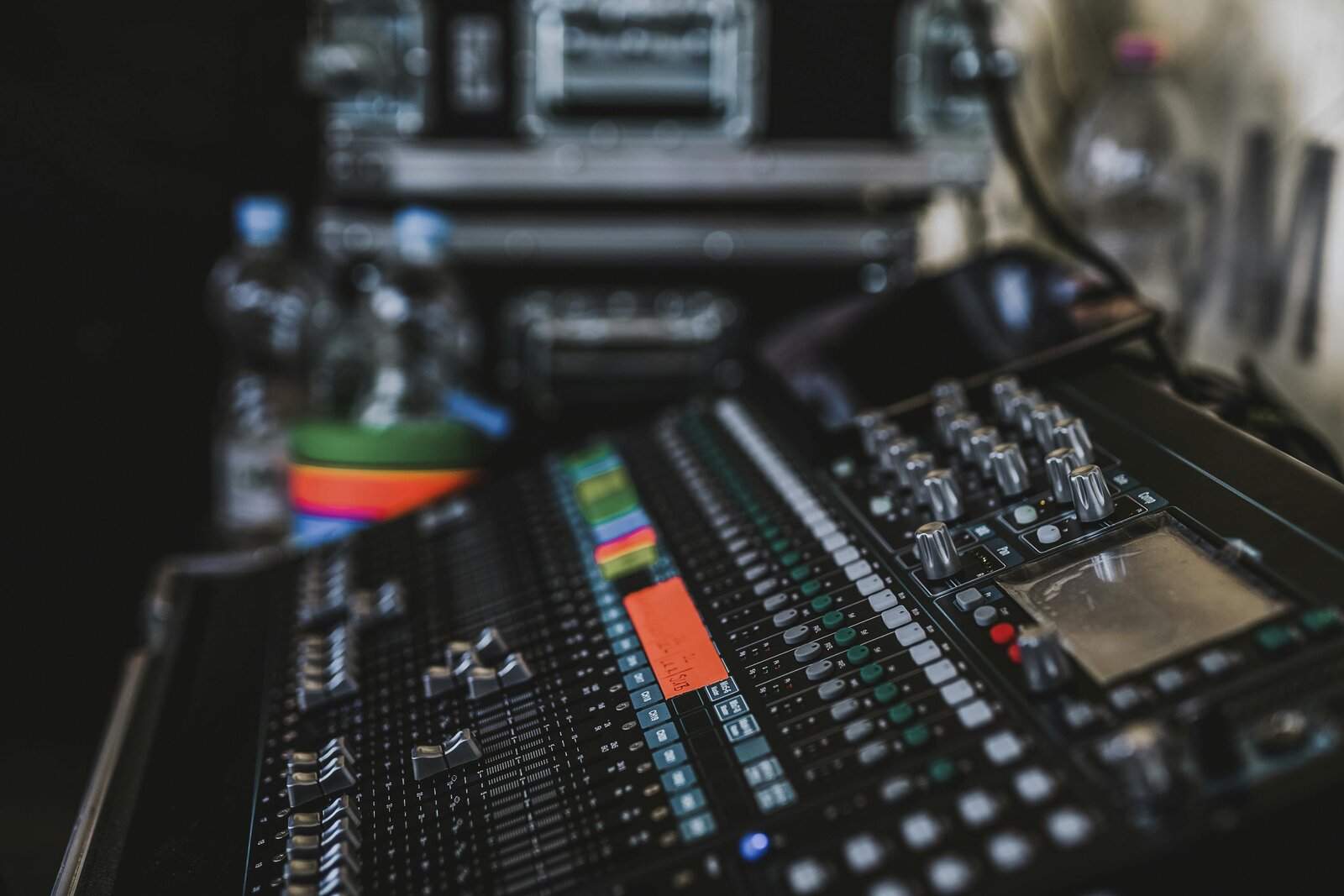
In the modern era, the landscape of music recording and playback has been revolutionized by digital technology. Unlike the analog process, where sound waves are directly captured and stored on physical media, digital recording involves converting the analog audio signal into a series of discrete numerical values. This process, known as sampling, allows for the representation of the continuous analog waveform as a sequence of digital data points. The sampling process occurs at a predetermined rate, which determines the number of times the analog signal is measured and converted into a digital value per second. For example, the standard sampling rate for audio CDs is 44,100 samples per second, often referred to as 44.1 kHz. This means that for every second of music, there are 44,100 distinct numerical values stored on the digital medium. Each of these values represents the amplitude of the analog signal at a specific point in time.
In addition to the sampling rate, another crucial factor in digital audio is the bit depth, which determines the resolution and dynamic range of the recorded audio. CD-quality audio typically uses a bit depth of 16 bits, allowing for 65,536 possible amplitude values for each sample. Higher bit depths, such as 24 bits or 32 bits, provide even greater resolution and a wider dynamic range, capturing more subtle nuances and details in the audio.
Once the analog signal has been sampled and converted into digital data, it can be stored on various digital media, such as CDs, DVDs, or hard drives. This digital format offers several advantages over analog recordings. Digital audio is less susceptible to degradation over time, as the numerical values remain consistent and can be perfectly replicated without any loss of quality. Additionally, digital audio allows for easy editing, manipulation, and distribution of the recorded material. When it comes to playback, the digital audio data must be converted back into an analog signal that can be sent to headphones or speakers. This process is known as digital-to-analog conversion (DAC) and is performed by a dedicated component within the digital audio player. The DAC reads the numerical values stored on the digital medium and reconstructs the original analog waveform based on those values. The reconstructed analog signal is then amplified and sent to the output devices for listening.
While digital audio offers numerous benefits, such as improved noise reduction, precise editing capabilities, and easy distribution, some audiophiles argue that the conversion process from analog to digital and back to analog can introduce certain sonic artifacts or alter the characteristics of the original sound. This has led to ongoing debates about the perceived superiority of analog recordings over digital ones, with some individuals preferring the warmth, naturalness, and imperfections associated with analog media. To address these concerns and cater to the demands of discerning listeners, the concept of High-Resolution Audio (HRA) has emerged and taken the world by storm through music streaming applications and services. HRA refers to digital audio formats that offer higher sampling rates and bit depths compared to CD-quality audio. Common HRA formats include 96 kHz/24-bit, 192 kHz/24-bit, and even higher specifications. These formats aim to capture and preserve more of the original analog signal's nuances, resulting in a more detailed and accurate representation of the recorded sound. Check out our HiRes Music Downloading Guide to find out more.

However, the benefits of HRA are subject to debate, as the human ear's ability to perceive the differences between CD-quality and higher-resolution audio is limited. Additionally, the entire audio chain, from the recording equipment to the playback devices, must be capable of handling and reproducing the higher-resolution formats for the listener to fully appreciate any potential improvements. Regardless of the ongoing debates surrounding digital audio and its impact on sound quality, there is no denying that digital technology has revolutionized the way we record, store, and consume music. The convenience, portability, and accessibility offered by digital formats have made music more readily available to a wider audience than ever before. As technology continues to advance, it is likely that we will see further developments in digital audio, pushing the boundaries of sound quality and immersive listening experiences.
With the rise of streaming services and wireless connectivity, DACs like those from iFi Audio have evolved to support Bluetooth, allowing for seamless integration with smartphones and other mobile devices. Many modern DACs also feature digital inputs for connecting to computers or other digital sources, ensuring versatility in your audio setup. Notably, some DACs even support MQA (Master Quality Authenticated) decoding, unlocking the full potential of high-resolution audio files. Beyond just conversion capabilities, DACs often incorporate a headphone jack, enabling direct connectivity to your favorite headphones for an immersive listening experience. While specifications like bit depth and sampling rates are important considerations, the true test of a DAC lies in its ability to faithfully reproduce the nuances and emotions of your music, breathing new life into your audio journey. The technology is ever changing and advancing, but the necessity of converting digital-to-analog will forever stay one of the most important functions in your HiFi audio system.
The Google Translate of Your Audiophile System

Our ears can only perceive analog signals, which are continuous waveforms that fluctuate in amplitude and frequency over time. However, most modern audio sources, such as compact discs, digital downloads, and streaming services, store audio data in a digital format, which consists of binary code represented by ones and zeros. To make this digital data audible, we need a device that can convert it into an analog format that our ears can interpret. This device is called a digital-to-analog converter (DAC). Unlike digital sources, traditional analog sources like AM/FM radio, vinyl records, and tape recordings do not require conversion since they already produce an analog signal. However, for digital audio formats, the DAC acts as a "translator," much like how a human translator converts English to Spanish or vice versa.
The DAC's primary function is to translate the digital data from stored audio files into an analog electrical signal. This process involves converting the binary data into a series of samples at thousands of set times per second, known as the sampling rate. The DAC outputs these samples, which are then connected to form a continuous waveform that approximates the original analog signal. However, the conversion process is not flawless, and issues can arise that differentiate the performance of various DACs. Some DACs may introduce noise or distortion during the conversion process, resulting in a degraded audio quality. Others may struggle with accurately reproducing the dynamic range or frequency response of the original signal.
To address these potential problems, audio enthusiasts and manufacturers often invest in high-quality DACs that employ advanced techniques and components. These DACs aim to minimize conversion errors and preserve the integrity of the original digital data, ensuring that the resulting analog signal is as faithful as possible to the source material. Furthermore, the performance of a DAC can be influenced by various factors, such as the quality of the digital audio files, the sampling rate, and the bit depth. Higher sampling rates and bit depths generally result in a more accurate representation of the original analog signal, allowing for better sound quality and fidelity.
If Most of My Devices Already Have A DAC, Why Do I Need Another One?
Phones and computers today are amazing pieces of technology. They do a thousand things well, but in the case of audio, they get the job done (barely). In the case of recording, most times engineers do not use the mic input on their computer tower to record their audio, so why would you use your standard audio output in the same way? Standalone devices do a much better job at this because they are designed and manufactured to do one thing, and one thing only. Even though most modern devices like smartphones, computers, and some audio components have built-in DACs, there are several reasons why audiophiles and enthusiasts choose to use a standalone (external) DAC:

- Superior audio quality: The DACs integrated into devices are often basic and designed for general use. Standalone DACs, especially high-end models, employ superior components, advanced circuitry, and more robust power supplies. This results in better sound quality, improved dynamic range, lower noise floor, and more accurate conversion of the digital signal to analog.
- Dedicated purpose: Standalone DACs are designed solely for audio conversion, whereas the built-in DACs in devices are multi-purpose and may be influenced by other components or processes running on the device. A dedicated DAC can focus solely on the conversion process, leading to better performance.
- Bypassing the internal audio path: In many devices, the internal audio path (from the source to the built-in DAC) can introduce noise, interference, or quality degradation. By using an external DAC, you bypass the internal audio circuitry, potentially improving sound quality.
- Upgradeability: With an external DAC, you can easily upgrade or replace it with a better model as your needs or budget evolves, without having to replace the entire device.
- Connectivity options: Standalone DACs often offer a wider range of input and output connections, such as coaxial, optical, USB, and balanced outputs, allowing for greater flexibility in connecting to various sources and amplifiers or headphones.
- Support for high-resolution audio: Many external DACs can handle high-resolution audio formats (e.g., DSD, 24-bit/192kHz) that built-in DACs may not support or struggle with.
- Additional features: Some standalone DACs include additional features like headphone amplifiers, volume controls, or even equalization options, providing a more comprehensive and customizable audio experience.
While the built-in DACs in devices are designed for convenience and general use, audiophiles and enthusiasts often prefer the superior sound quality, flexibility, and potential for upgrades offered by dedicated standalone DACs, especially when paired with high-end audio systems or headphones.
How to Buy a DAC: Step-by-Step Guide
So now that you understand the importance a DAC plays in your audio system, signal chain, and sound quality–how the heck do you buy one?
Sure you can go to Google and type in DACs but you might freeze once you see all the different types of DACs that pop up. So let's decode it, step by step.
1) Picking a Source Device
The first step in purchasing a DAC is to identify what your source device will be. This is the device you're using to access your music. Say a computer, phone, tablet, or physical media.
How you plan to enjoy your music will help you identify which type of DAC you need–which is the next step.
If you're planning on using your phone for music playback, you have two main options: playing locally stored music files or using streaming apps. With the growing popularity of high-resolution audio, there are now numerous streaming services offering lossless and hi-res music streams. To get the most out of your phone's audio capabilities, you'll want to connect an external DAC, either in the form of a dongle or a USB DAC, depending on the available ports on your device (USB-C or Lightning).
Dongle DACs are incredibly convenient for use with smartphones and tablets. They're simple plug-and-play devices – just connect them to your phone's port, and your device should automatically detect the DAC and set it as the primary audio output. It's a seamless process that requires minimal setup. The same principle applies to tablets and laptops. Simply plug in your DAC, and it should be detected and configured as the main audio output. However, for Windows PCs or Macs, you might need to go through some additional configuration steps and driver installations to ensure your computer recognizes the DAC properly and routes audio through it.
With a high-quality DAC connected to your phone or tablet, you'll be able to enjoy your locally stored music files or streaming services with significantly improved audio quality, greater detail, and a more immersive listening experience. The DAC will bypass your device's built-in audio circuitry, providing a dedicated path for pristine audio conversion and output. Whether you're a casual listener or an audio enthusiast, investing in a good portable DAC can elevate your mobile audio game, allowing you to truly appreciate the nuances and fidelity of your music library or streaming service on the go.

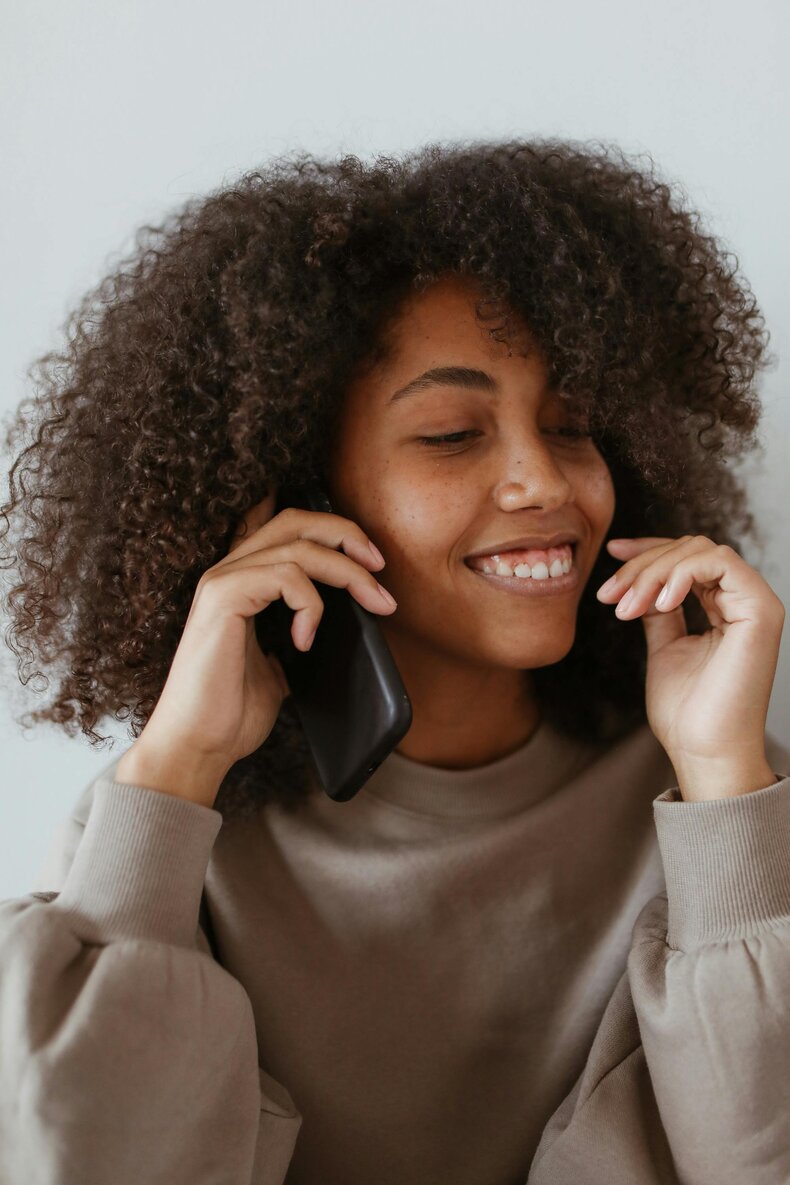
While digital streaming has become increasingly popular, many audiophiles still cherish their collections of compact discs. For those who want to get the most out of their CD libraries, Cayin's Mini CD-MK2 is an outstanding option. The Mini CD-MK2 is a compact disc transport that features a built-in, high-end DAC chipset and upsampling capabilities. This means that even if your source is your extensive collection of compact discs, you can still enjoy a modern, high-fidelity listening experience. The upsampling feature ensures that the digital audio data from the CDs is processed and converted to a higher resolution, resulting in improved sound quality and greater detail retrieval. It's worth noting that despite the rise of digital formats, many manufacturers continue to produce high-quality CD players, which have evolved significantly over the years. These modern CD players incorporate advanced technologies and components to extract the best possible sound from physical media.
For those who prefer a more integrated and streamlined approach, using a dedicated music server or streamer like the Roon Nucleus can be an excellent choice. If you're a Roon user, you can set up your computer as the core, with your music library installed locally. Alternatively, you can add the Roon Nucleus as a dedicated core. The Nucleus offers several advantages over using a traditional computer. First, it's a purpose-built device designed specifically for storing, processing, and playing back music. Unlike a computer, which requires logging in, starting up, and shutting down, the Nucleus stays on all the time, providing a seamless and always-ready music experience.
The Nucleus is optimized for audio playback, with a focus on minimizing noise, reducing power consumption, and delivering superior sound quality compared to a general-purpose computer. Computers can be noisy, slower, and consume more power, which can potentially introduce interference and degrade the overall audio performance. Whether you choose to stick with your beloved CD collection and a dedicated transport like the Cayin Mini CD-MK2, or opt for a more integrated solution like the Roon Nucleus, the key is to find a setup that aligns with your preferences, allows you to enjoy your music collection to the fullest, and provides the level of fidelity and performance you desire.


If you want to set up a DAC with your computer, you have several options to choose from, depending on the type of connection and level of functionality you desire. For a simple and compact solution, you can opt for a USB dongle DAC. These small devices connect directly to your computer's USB port (typically USB-C on modern systems) and provide an easy way to upgrade your computer's audio capabilities without taking up much space. If you're looking for more features and connectivity options, a dedicated USB DAC might be a better choice. These external DACs offer a wider range of inputs and outputs, including coaxial, optical, and balanced connections, allowing you to connect to a variety of audio sources and amplifiers or headphones.
For the ultimate desktop experience, you might consider a full-sized desktop DAC. These larger units often incorporate more advanced components, robust power supplies, and additional features like built-in headphone amplifiers or volume controls, providing a comprehensive and high-performance audio solution. Another option for desktop computers is to use a dedicated DAC card or a high-end audio card. These cards are installed directly into your computer's PCI or PCI-Express slots, effectively replacing your computer's built-in audio circuitry with a dedicated, high-quality DAC solution. These cards typically offer a variety of output options, allowing you to connect to external amplifiers, speakers, or headphones.
Regardless of the specific DAC you choose, most will interface with your computer via USB connection. This allows you to take advantage of your computer as the source for your music, whether you're playing back files from your local library or streaming from installed applications. When using your computer as the source, the DAC will be responsible for converting the digital audio data from your computer into an analog signal that can be amplified and played through your speakers or headphones. This conversion process is crucial for ensuring high-quality audio output and enabling you to take full advantage of your computer's music playback capabilities. It's worth noting that some DACs may require additional driver installations or configuration steps, especially when used with desktop computers. However, the process is generally straightforward, and many DAC manufacturers provide clear instructions and support resources to assist with setup and optimization.


Network-connected DACs are a versatile and convenient option for music enthusiasts looking to elevate their audio experience. These DACs can connect to various sources, such as a Roon core, a computer, or any other compatible device, without the need for a direct physical connection. One of the key advantages of network-connected DACs is their ability to integrate seamlessly into a home network, allowing you to control and stream music from various devices, including laptops, tablets, or smartphones. In some cases, these devices can even serve as remote controls, providing a user-friendly interface for navigating and controlling your music playback.
If you're truly looking to take your audio setup to the next level, companies like Aurender and dCS offer some of the best all-in-one units that combine high-end DACs, streamers, amplifiers, and even proprietary software for music streaming, cataloging, and playback. Aurender, in particular, is renowned for their top-of-the-line streamers that feature advanced DAC technology, robust audio processing capabilities, and seamless integration with various music sources and platforms. These units offer a comprehensive solution for music lovers, providing a complete ecosystem for high-fidelity audio playback, management, and control.
Similarly, dCS (Data Conversion Systems) is a highly respected brand in the audiophile community, known for their exceptional DACs and digital audio components. Their all-in-one units combine state-of-the-art DAC technology with network streaming capabilities, allowing you to access and enjoy your music library with exceptional sound quality and precision. When delving into the world of network-connected DACs and high-end audio solutions, you can expect to unlock a realm of advanced functionality and features. These devices often incorporate sophisticated software platforms, offering extensive music library management, metadata handling, and even dedicated control apps for seamless operation.
However, it's important to note that such high-end solutions can come with a significant price tag, reflecting the level of engineering, premium components, and cutting-edge technologies employed in their design and manufacture. Ultimately, network-connected DACs provide a level of flexibility and convenience that traditional, physically connected DACs cannot match. They allow you to integrate your audio system seamlessly into your home network, enabling you to access and control your music from various devices while benefiting from superior sound quality and advanced audio processing capabilities.
Different connection ports can affect the signal integrity and, consequently, the overall sound quality of your system. It's essential to prioritize the connections based on their potential for delivering the best possible audio fidelity. Here's the order in which you should consider using the available connections on your DAC, starting with the best option for optimal sound quality:
- I²S (Integrated Interchip Sound): This is considered the superior connection type, as it allows for a direct digital audio transfer between the source and the DAC, minimizing potential signal degradation.
- AES/EBU or Balanced XLR: These balanced digital connections offer improved noise rejection and can transmit audio signals over longer distances without significant quality loss.
- S/PDIF (Sony/Philips Digital Interconnect Format): This can be either coaxial RCA or optical Toslink connections. While not as ideal as the previous options, S/PDIF is still a common and reliable connection for digital audio transmission.
- USB: While convenient and widely available, USB connections are generally considered the least desirable option for achieving the best possible audio quality. However, modern high-speed USB connections (USB 2.0 and above) can still provide excellent performance, especially when paired with high-quality DACs and proper shielding.
It's important to note that DACs often come with various input and output configurations, offering a combination of the aforementioned connection types. When setting up your DAC, it's generally recommended to prioritize the connections in the order listed above, as each successive option may introduce more potential for signal degradation or interference.
You need to think about all the different parts in your audio setup, like your source device (computer, phone, etc.) and any other components you have connected. Making sure all the connections between these parts are compatible and properly matched is really important to get the best sound quality possible. The connection order I mentioned (I2S, AES/XLR, S/PDIF, USB) is a general guide, but you should always check the instructions from the manufacturer of your specific DAC and other audio gear. Your personal preferences, the room you listen in, and other factors can also affect which connections work best for your setup. By understanding the pros and cons of each type of connection, you can make smart decisions when setting up your DAC. This will help you get the absolute best audio experience from your high-quality audio system. Don't be afraid to do some research and ask for help if you need it!
Digital Audio Players (DAPs) are an excellent choice for audiophiles and music enthusiasts who demand high-quality sound and the ability to enjoy high-resolution audio files on the go. These dedicated music players are designed with built-in, high-end digital-to-analog converters (DACs), making them an all-in-one solution for Hi-Res audio playback. Unlike smartphones or traditional music players, DAPs are purpose-built devices focused solely on delivering the best possible audio experience. Their internal DACs are typically of superior quality, incorporating advanced components and circuitry designed to accurately convert digital audio data into an analog signal with exceptional fidelity, detail, and dynamic range.
One of the key advantages of DAPs is their support for a wide range of high-resolution audio formats, including FLAC, DSD, and PCM files with resolutions up to 24-bit/192kHz or even higher. This allows audiophiles to fully appreciate the nuances and intricacies of their favorite recordings, revealing details and subtleties that may be lost or compressed in lower-quality formats. Many DAPs also feature dedicated amplifier sections, with some models offering balanced output options for compatible headphones or external amplifiers. This ensures that the converted analog signal is properly amplified and delivered to your headphones or speakers with minimal distortion or noise, resulting in a truly immersive and engaging listening experience.
In addition to their impressive audio capabilities, DAPs often boast sleek and portable designs, making them ideal for on-the-go listening. Some models even incorporate features like Wi-Fi connectivity, allowing you to stream music from compatible services or access your personal music library wirelessly. While DAPs may come at a higher price point compared to traditional music players, their focus on audio fidelity and support for high-resolution formats make them a worthwhile investment for those who are serious about their music listening experience. By combining exceptional DAC technology with portable convenience, DAPs offer the ultimate solution for enjoying your favorite tracks with uncompromising sound quality, no matter where your adventures take you. Whether you're an avid audiophile, a music professional, or simply someone who appreciates the finer details in their music, a high-quality DAP can be a game-changer, elevating your listening experience and allowing you to fully immerse yourself in the rich tapestry of sound.
2) Types of DACs
When and Where to Use a DAC: Ergonomics
1) Dongle DACs: For those who don't want to spend a lot of money, but want something that they can simply plug into their phone or laptop and get some quality gains on their sound. If you fall into this category then you're going to want something resembling a dongle DAC. A small, no-frills DAC that you can pop into your phone, plug in your headphones, and you're good to go.
2) USB DACs: The next person might want to spend a decent amount of money on a DAC with more features, more power, and the ability to use it on the go or even as a small desktop DAC if space is a consideration. These individuals will likely go for a USB DAC - which I like to designate as different from dongle DACs because whereas dongles connect via USB, these larger DACs typically have their own internal battery. Dongle DACs are powered passively by the source device.
3) Desktop DACs: Lastly, there are those who are going to want big, beefy standalone or desktop units with even more power, features, and of course a larger footprint. These are going to be more expensive, but give you the best in conversion and sound quality. These are the desktop DAC people. You're not toting these puppies around with you. Put them up on the shelf or wherever you put your music gear and let them work their magic. This is for the audiophile or music lover who wants the best of the best.

Dongle DACs

USB DACs
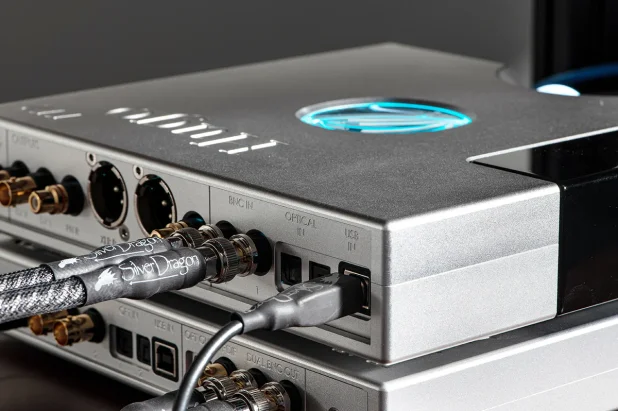
Desktop DACs
Ergonomics and how you actually listen to music are crucial factors to consider when choosing the best DAC for your needs. Even if you have the budget for one of the most amazing desktop DACs on the market, it may not be the ideal choice if you travel frequently for work and are rarely home to use it. When considering a DAC purchase, ask yourself:
- Where do you typically listen to your music? If you're often on-the-go, a portable DAC that can connect directly to your phone may serve you better than a bulky desktop unit.
- What is your primary source for your music library - your phone, a computer, streaming services? This will impact what type of DAC connections you need.
- Do you have headphones that require more power to drive them properly? This could sway you towards a larger, more powerful USB DAC rather than a simple dongle DAC.
There are many factors that come into play, so take your time and carefully consider all your listening habits and needs. A DAC designed ergonomically for how you actually consume music will provide the best experience. Don't just go for the most expensive option - choose wisely based on your specific listening style and requirements.
Our Favorite Dongle DACs
All we have left to talk about really, is, helping you find the best DAC for you and your setup. And in many ways, that can be one of the most challenging parts. We're gonna start at the best entry point for better sound: dongle DACs. They're small and affordable, and if you're just looking for something to connect to your phone or tablet, they make huge sound quality gains for the music listener. A lot of times we'll just start off by asking, where do you plan to listen to music? Are you wanting to jam out while on the bus or train during your commute? Do you want to just sit at home in peace in a designated listening space? Maybe you just want a nicer setup when working at your desk. There are tons of places to listen to music and just as many DACs to accompany them.
The most affordable of the bunch here and easiest to take with you, USB dongle DACs can fit in your bag or pocket. They can be incredibly small. They're typically the size of a flash drive and either has a detachable or sometimes attached cable, like a dongle. I know a lot of people attach one to their phones for some serious sound quality gains compared to their phone's off-the-shelf DAC chip. The same goes for a laptop or tablet. The biggest difference between a dongle DAC and larger USB DACs which we'll take a look at in the next section is that dongle DACs are powered by the source device like your phone or laptop. They don't have an internal power source like a battery, so this results in smaller, lighter, and more affordable devices. Here are our favorite USB dongle DACs at Moon Audio:
Clarus CODA Headphone Amplifier DAC
Clarus CODA- it's a nice and robust size, much like a flash drive, and similarly, it has a cap that covers the USB type A connection. It also comes with an adapter for USB C connection and it has a simple 3.5mm unbalanced headphone jack on the back. It can drive most headphones well, and it has a nice detailed, and balanced signature. A big plus here is the physical volume up and down buttons on the side that also double as filter selections. The CODA has always been a great seller and I'm a big fan of the robust sound this thing can produce, especially when connected to my laptop, which I do quite a bit.
FROM THE REVIEW: The Clarus CODA is one of the best portable USB DACs at/under $300 on the market. Its signature SABRE sound is proven and popular, and the construction is durable. What puts the CODA above the competition however are the features and functionality, giving you way more control over your music than a simple plug-and-play device (despite being just as easy to install and use). Don't be fooled by the small size, because it packs a lot of punch and can drive most headphones you throw at it. The CODA is a solid recommendation for those wanting a big, clean sound while being small enough to throw in your bag for everyday use.
Cayin RU6 Portable USB DAC/Amp Dongle
The RU6 by Cayin is one of the best-sounding portable DACs at this price range. Using a discrete 24-bit r-2r ladder DAC (we'll get more into DAC types in a later section), the RU6 includes options for oversampling and also has physical control buttons. The tiny OLED screen is just helpful enough for info and has one of the most natural and balanced sounds for a DAC at this size and price. Cayin just puts out really great-sounding audio gear at superb prices. People just cannot say enough good things about the RU6 no matter where you look on the internet, reviews, and forums which is why we have no problem recommending it to anyone looking for some of the best sound at this size. Also - it has both 3.5mm and 4.4mm headphone outputs, so that's awesome. Most USB dongles here only have one. A big plus for the RU6.
DISCRETE 24-bit R-2R LADDER RESISTOR: The basic idea of the R-2R ladder is a matched pair of two resistors, the first is "R" and the other is "2R" which has twice the value of R. To achieve 24bit R-2R decoding, you need 48 resistors ( 23xR and 25x2R ) for one channel or 96 pieces of high precision resistors for stereo. R-2R is famous for its natural and realistic sound signature, and it’ll offer a very different experience to music lovers. To achieve 24-bit R-2R decoding, Cayin uses resistors that can deliver extreme precision and remain stable during temperature changes.
Astell&Kern AK HC4 Portable USB DAC
Introducing the new high-end portable USB DAC dongle from Astell&Kern: the HC4. The successor to the popular HC3 and HC2, both of the previous versions were designed with either a single 3.5mm (unbalanced) headphone jack or a 4.4mm (balanced) headphone jack. The HC4 now brings those two together for the first time, offering both a balanced and unbalanced headphone jack on a single device. Equipped with an AK4493S DAC, the HC4 portable DAC provides exceptionally clean audio quality, with a musical presentation with plenty of detail and resolution. New to the HC4 model is the design of a detachable cable, giving you the option to switch connector types as needed. We like this design much better than the attached cable design of the previous generations. The HC4 headphone amplifier is equipped with a USB type-C connector and also supports UAC1.0 for gaming scenarios.
NEW ADVANCEMENTS: The HC4 expands upon its highly acclaimed predecessors, the HC2 and HC3, delivering even more perfected sound in various usage scenarios through an advanced design. Featuring dual output headphone jacks, the HC4 is compatible with most IEMs and headphones, The AK4493S DAC chip delivers true Hi-Fi sound, along with Digital Audio Remaster (DAR) technology. It brings a level of Hi-Fi sound previously exclusive to Astell&Kern's digital audio players (DAPs), to the AK HC4. Enjoy Hi-Fi USB Audio like never before.
Our Favorite USB DACs
Now, what if you wanted a little more? More features, more power, more...options? Well, then we have some of those for you. These USB DACs are a bit different than the last section. They have internal batteries, better input and output options, some have wireless options to connect via Bluetooth, larger screens, dual headphone jacks, and much more power. These USB DACs provide the user with lots more options when it comes to listening to your favorite music whenever you want. Do you have more power-hungry headphones but still like to be portable? Step up your audio game with these portable USB DACs:
iFi Audio GO Blu Headphone Amp DAC
The iFi Audio Go Blu might be one of the most versatile DACs here, as along with Bluetooth capability, wired connection options, a built-in microphone for taking calls when connected to a phone, it's a lot like a Swiss army knife. Both balanced and balanced headphone jacks, and a dedicated volume knob. It's somehow packed with all these quality features at a super low $199. It's one of the only DACs you'll find on the market with a microphone, and combined with hi-res BT codec options, the super-small size, and an eight-hour battery life - there's no reason why you shouldn't have this in your audiophile-to-go bag.
FROM THE REVIEW: The Go Blu is a neat portable USB DAC Amp that packs more features than products 2-3 times its price. It's small enough and affordable enough that if you're looking for a solid portable audiophile-grade solution with a swiss-army knife of configurations, it would be tough NOT to recommend checking out the Go Blu from iFi Audio. Yes, it's a budget DAC amp but the construction quality is top-notch, and iFi uses premium materials with separate BT, DAC, and Amp stages for maximum performance. The CS43131 chip sounds robust and detailed, the iFi sound enhancements aren't just gimmicks - they actually provide some nice added bass response and soundstage to the music if you prefer. There's not much to be disappointed at here when taking everything into consideration.
Chord Electronics Mojo 2 DAC Headphone Amp
Mojo 2: quite possibly one of the most popular DACs in the entire audiophile market, the Mojo 2 from Chord Electronics is compact, has plenty of power, filter and EQ options, and dual headphone jacks. Chord makes some of the best-sounding gear out there, and if you're a detail freak - then you'll really love the Mojo 2. It pairs perfectly with phones, laptops, and even desktop computers if you're looking for a small setup. The Mojo 2 is a substantial upgrade from the original, which is why it's one of our favorite DACs at Moon Audio.
FROM THE REVIEW: The sonic upgrades are there - don't be fooled by some of the specs being identical. Sound doesn't just lie in new chips. Chord has a design process where they assess what really needs to be improved, and the Mojo 2 is a refinement in that art. Better transparency, more depth, improved bass response, larger battery - it's all there. And this is where I look to you, current Mojo 1 owners. I consider the best upgrading talking point to be the features. Let's just ignore the fact that the Mojo is seven years old already and probably in need of a new battery anyway. But it's the new features and upgrades that allow the listener more control over their music: Low/High gain options, better color-coded indicators (which will take some time to learn), new menu filters, intelligent desktop mode, EQ, and much more. Yes, I would say it's a worthwhile upgrade even if you have the existing Mojo.
iFi Audio xDSD Gryphon Headphone Amp DAC
The Gryphon from iFi Audio is a strong runner-up, as you can see in our DAC Face-off video which we'll link to in the description below. The Gryphon basically has everything that people wanted in the Mojo 2 but never got - Bluetooth options, a display screen, a balanced connection, and much more. iFi has their proprietary X bass and X space sound enhancements which actually do a lot for the overall sound, and I find myself using them more than not. I'm not a bass head or anything, they just enhance the music, and that's enough for a lot of people. It's cheaper than the Mojo 2 as well, at $599, so if those features appeal to you, then I wouldn't hesitate to recommend the Gryphon for just about any scenario out there. It's one of my personal favorites.
FROM THE REVIEW: I'm just gonna go ahead and say it: the Gryphon has everything that audiophiles wanted in the Mojo 2. The obvious comparison I left for last, as the Mojo 2 is without a doubt what the Gryphon is gunning for. I don’t think it sounds better than the Mojo 2, but I might like the sound better than the Mojo 2 if that makes sense. The Mojo 2 will give you more control over your EQ, but the Gryphon just has easier tone controls that sound great in their own right and some major additional features that you won't find on the Mojo 2 that many people wanted. To me, it’s the better value, it’s the more versatile DAC and amp, and it has tons of power. Bluetooth, a really great sounding DAC, and a premium experience that I think many will appreciate. I’m glad we picked up iFi here, and I’m really impressed with the Gryphon overall.
Our Favorite Desktop DACs
Desktop DACs are the larger counterparts of their portable siblings. Bigger, more powerful, more features, better sound, and better inputs and outputs. They come in various shapes, sizes, price points, and of course features. You can get a desktop DAC that's also a hi-res music streamer, or a server. You can even get some DACs that are all-in-one complete systems. So, why would you want a desktop DAC? If you're looking for something that is compatible with your full hi-fi system at home or want to integrate speakers, headphones, whatever, then these are the ones you're going to want. Here are just a few of our recommended desktop DACs:
Matrix Audio X-Sabre 3 MQA DAC
The X-Sabre 3 Pro is one of my favorite desktop DACs at Moon Audio. I'm a big fan of the expansive and detailed SABRE sound, and Matrix Audio has made some significant improvements over the last gen X-SABRE to make this one of the most feature-rich DACs on the audiophile market. It has streaming integration with the newly implemented LCD screen - it's small, but Matrix did a good job with the layout - it gives plenty of information and keeps the sleek profile of the unit. I'm a big fan of the glass top and the touch-sensitive buttons. I/o is great too - RCA, XLR, Coax, optical, I-squared S, USB Audio, and on and on.
FROM THE REVIEW: The X-SABRE 3 DAC is an upgrade in every sense of the word from the previous generation DAC. Matrix Audio has put a tremendous amount of effort into improving one of the best DACs on the market and making it even better, more resolute, and packed with the latest features bringing it up to date and putting it ahead of the competition. The addition of Tidal and Spotify Connect, combined with Roon Ready certification make the X-SABRE 3 the perfect hi-res streaming host to add to your system. The DAC is one of the best sounding on the market - hands down - and will provide a level of detail and clarity few DACs can match.
Chord Electronics Qutest DAC
The Qutest DAC from Chord is our most popular stand-alone DAC at Moon Audio. It's Chord's "pure" DAC - it's just a DAC and nothing more. It retains Chord's amazing detail retrieval and award-winning proprietary FPGA technology. The Qutest is designed and precision-milled from a solid aircraft-grade aluminum block. It's sturdy, hefty, and more importantly isolation from external vibrations and interference. With filters, input selection controls, RCA outs, and a small footprint, it's an amazing standalone DAC for any system.
FROM THE REVIEW: The Qutest improves on the 2Qute in every way possible. Paired with the Chord Anni amplifier and the Chord Huey phono stage for turntable integration, and you have a full hi-fi system that fits neatly on your desk or shelf without taking up hardly any room. It's hard to beat the Chord sound and the quality of their products, and we're big fans of the form factor, especially for those where real estate is a factor. You're not missing out on quality sound here despite the Qutest's size, and it's another home run for Chord and their DACs. It's no wonder the Qutest is our best-selling DAC to date.
Chord Electronics Hugo 2 DAC Headphone Amp
On the Flip Side, if you want a portable version of the Qutest to use in both a desktop or portable scenario take a look at the Chord Hugo 2. The Chord Hugo 2 does not need much of an introduction. It adds a battery power supply and a headphone amplifier to the Qutest DAC circuits with some other fun features. No, you are not chained to a desk but can take it on the go. It rules as the King of portable Headphone Amp/DACs. The big difference here is the portable format - the Hugo 2 has headphone jacks. Make sure to take a look at our Chord Hugo 2 review for more information.
FROM THE REVIEW: Hearing is believing. Even after 5 years on the market the Hugo 2 still manages to impress. It's a substantial upgrade from the original Hugo in both sound and internal components. The Hugo 2 doesn't depart much from the Chord house sound, being analytical and detailed, and it has some of the best dynamic range I've heard in a small package. Don't let the size fool you either, the Hugo 2 can pull its weight even in larger desktop setups too, offering a great selection of inputs and outputs to fit in almost any audio system (headphones, IEMs, and desktop setups). Yes, it's on the expensive side, but be assured that you'll get much more from your music. You don't always get what you pay for, but in this case, you get much, much more.
TEAC UD-701N Headphone Amplifier, USB DAC, and Network Player
The TEAC UD-701N is another desktop DAC type that combines a headphone amplifier, network player, analog preamp and more into one device. The 701N uses a Delta Sigma DAC - it has some nice bottom-end presence, but it's the hyper-detail and natural signature that really stands out. It's fully balanced, includes great port selection and the streaming integration with the HR Music Streamer application is a breeze. It's one of the best-sounding all-in-one units here at Moon Audio, and if you're looking for a DAC that does it all, then look no further.
FROM THE REVIEW: Ultimately, the TEAC UD-701N is an impressive little black box. The design is sleek, and is a great option for a Roon Ready endpoint or for those who rely heavily on streaming services - and it will especially help you get the most out of your higher-resolution streaming audio. One of the biggest draws to the unit however is the fully balanced circuitry combined with the Delta Sigma discrete DAC. The sound is superb, and combined with resolute headphones, makes for an outstanding standalone system. Of course, you can configure it as a single element in your system as well, either a designated streamer source, an analog preamp, a USB DAC, etc; it's an incredibly versatile device that excels at each individual component, not just the unit as a whole. If you’re looking for a music player that does it all, then the TEAC UD-701N is a solid choice that we give a big thumbs up to.
dCS LINA Network DAC
If you're looking for the best of the best, one of the top DACs on the audiophile market is the LINA network DAC from dCS. dCS' proprietary Ring DAC technology is at the center of the LINA. Instead of using off-the-shelf DAC chips, dCS builds its Ring DACs from the ground up. One of the key advantages of the Ring DAC is its upgradability via firmware updates. The Ring DAC uses a network of FPGAs that are running proprietary dCS software that control the digital-to-analog conversion process as well as digital filtering. Unbalanced, balanced outs, SPDIF, AES, USB - hook it up to anything, especially the corresponding clock and amplifier for the full Lina stack. It's about as end-game as you can possibly get.
FROM THE REVIEW: Let me get straight to the point: The LINA simply blows my mind. I consider it an end-game headphone setup. The LINA DAC has exceptionally low noise performance with vanishingly low distortion, ultra-wide resolution, and soundstage. The DAC does not impose or create any coloration to the sound. The headphone amp is true, clear, and just steps out of the way of the music. It controls just about every headphone I tried with complete authority. Thanks to the LINA Clock combination, there is extremely low jitter. Moving forward, this will be my reference setup to which all other setups will be judged!
Do I Need A DAC Or An Amplifier?
An amplifier plays a crucial role in providing the necessary output power to drive speakers or headphones effectively. Depending on your setup or application, you might require additional amplification, especially if you're using power-hungry headphones with demanding drivers. For instance, if you're listening to music on your phone but it lacks the power to drive your headphones adequately, it will result in poor audio quality and low volume output, which is particularly important to consider in portable setups.
Apart from ensuring sufficient volume levels, a headphone amplifier also assists in bringing the volume control of your device to line level and providing the necessary "headroom" to drive your headphones optimally. Fortunately, many portable amplifiers are combined with digital-to-analog converters (DACs), offering a convenient all-in-one solution. The Chord Mojo 2 is an excellent example of such a DAC/amp combo.
Manufacturers are increasingly integrating DACs into their amplifiers for added convenience. Previously, you might have had to carry around multiple bulky devices: your phone, a separate DAC, an amplifier, and your headphones. Now, we have all-in-one solutions that streamline the process. Some models even allow you to deactivate specific functions depending on your setup. For example, if you only need to use it as a DAC, you can deactivate the amplifier or preamplifier option. However, it's crucial to research thoroughly, as not all DAC/amp combos offer the same level of configuration.
If your music source does not have an internal digital-to-analog converter, you will need a standalone DAC. It's important to note that a Digital Audio Player (DAP) will not be able to output a signal to a DAC like a computer or iPod does, as it already outputs an analog signal. If your music source, DAC, or speakers do not include built-in amplifiers (or lack sufficient power for your desired output), you will need a standalone amplifier for your audio system. These components are integral parts of your setup, and one device cannot be substituted for another, unless it is a combo device like a DAC/amp, as mentioned earlier.
The advantage of DAC/amp combos is their versatility and compatibility with various systems. Portable units can work well in both desktop and component scenarios, as well as on the go. With the right adapters, you can even use your smartphone as the source, and in cases like the latest iPhones that lack analog inputs, units like the Chord Mojo 2 can bypass the phone's internal DAC through the Lightning port. If you have high-resolution audio files on your phone, even audiophiles can enjoy a premium listening experience wherever they go.
Popular Questions about DACs
What is a DAC?
DAC stands for Digital to Analog Converter. It's a component - in your phone, laptop, tablet, audio device - that processes the digital data of your music and converts it to an analog signal. Once it has been converted to an analog waveform, you can send that to your amplifier and play the music on a speaker or headphones. Think of it as a translator. It's just taking that data and translating it to an analog signal that you can hear.
How does a DAC Work?
A DAC is essentially the Google Translate of your audio system. Apart from physical analog media like vinyl and tape, most music today is digital. Just 1s and 0s. And since our ears cannot hear digital data, we need a method of converting these 1s and 0s to an analog format so that it can produce sound waves and thus we are then able to hear it. The digital-to-analog converter does just that: converts the digital data to an analog signal. It takes those 1's and 0's and tracks them to a waveform pattern. To do this, it converts the bits of data from the stored files into an analog electrical signal at thousands of set times per second, called samples. The DAC outputs these samples into a waveform that intersects at all the sample points. However, problems can arise in the conversion process which as we will see later can set some DACs apart from each other. It's an integral part of your system that you can't do without - especially if you have a digital music library.
Why do we convert digital to analog?
The basic fact is that our ears are not designed to “hear” data. It's impossible. We can only hear analog signals like sound waves and vibrations, coming from an amplified source through the air. Therefore, we need a device that converts this data into an analog signal. The other factor has to do with the fact that most music today is recorded digitally. This means that the analog signals coming from the instruments and voices being recorded are stored digitally onto computers, mixed and mastered, and then optimized for digital mediums such as compact discs or online streaming and downloading. Analog media, like vinyl and tape, is making a comeback, but still, the majority of music and access to music out there is digital, and ultimately you need something to convert that data before you can hear it.
What makes a good DAC?
The quality of the converter chip doesn't necessarily play the biggest role in determining how "good" a DAC is. In fact, the overall audio signal path needs to be considered if we're specifically talking about the "sound quality" of a DAC. That being said, off-the-shelf factory DAC chips - like in your phone - are not very efficient or accurate at converting the data, so the result is a fair presentation of the music, but it leaves much to be desired. A good DAC chip converts the data efficiently and accurately, so that all the information in the data is transmitted to the analog signal. More data points result in a smoother waveform, thus resulting in more natural audio quality. Having multiple DAC chips can also make a difference in the effectiveness of the data conversion that is outputted. Higher-end DAC chipsets are usually Cirrus Logic, ESS, AKM, or Burr-Brown (of course there are others, but these are some of the most popular on the audiophile market). Some DACs themselves - if we're talking about the device alone - might not even use a proper off-the-shelf chipset. Chord DACs use FPGA and their own proprietary algorithms - and they sound phenomenal. This is another reason that you can't simply look at the chipset (or lack thereof) to determine if a DAC is good or not. You have to look at the complete picture, or in this case, the whole audio circuit or architecture from start to finish.
What kind of DACs are there and what would I need?
Here at Moon Audio we typically divide DAC types by ergonomic scenario. Do you travel frequently or do you like to listen to your music while on the go? Then perhaps a portable DAC like the Chord Mojo 2 or Clarus CODA would be appropriate for your personal use. USB DACs are a perfect portable option. Do you like to listen to music in the comfort of your home, or perhaps you have a designated space for your sound system? A desktop or tabletop DAC would be a good fit; the Hugo TT 2 is a great option, and the Chord Hugo 2 is a powerful portable DAC that can also serve as a dual-purpose DAC in your home system as well. There are many kinds of DACs for varying usage scenarios, and sometimes audiophiles use multiple types - so they always have good audio quality wherever they are. We could also get into the differences between AKM, ESS, R2R, Burr Brown, Cirrus Logic, and more – but that gets a bit technical and nuanced, so we’ll save that for further down the page.
DACs also come in various configurations, like standalone, or combined with streamers, or servers, and more. You have your Qutest DAC – which is a standalone unit – just the DAC – and our most popular DAC that we sell here at Moon Audio. Next is something like the Bricasti M3, which is a DAC combined with a headphone amplifier. Then you have devices like the Uniti Atom HE, which combines the DAC, a headphone amplifier, and a streamer. And lastly, there is the Aurender A20 – which Is a DAC, Headphone Amp, Streamer, and Server – complete with internal storage for your personal music library.
Does an external DAC make a difference?
Absolutely. Without a DAC, your digital data cannot be converted to an analog signal, and thus you won't be able to hear it. Every device you have with a speaker has a built-in DAC. Your phone has a DAC in it. Your AirPods have DACs in them. Your tablet and laptop have DACs in them. Your portable speaker you take to the beach - has a DAC in it.
The more important issue here is: that not all DACs are created equal. We mentioned that the DAC is like the Google Translate of your audio system. It translates the digital data to an analog signal. Are all language translators the same? No - they vary by skill. The same applies to internal factory DACs and external ones. An external DAC is built to do one thing and to do that one thing very well. That is why external DACs that are built for the sole purpose of converting this data are better than factory off-the-shelf converters.
What devices do NOT need DACs?
Since the DAC's job is to convert digital data, analog sources do not require a converter. Devices like tape decks and turntables are great examples of gear that read directly from analog mediums (tape and vinyl respectively). The device reads the analog signal in real-time, and then, through the help of an amplifier, transmits that signal to headphones or speakers. It's an easier and more ‘direct’ process than that of the digital world.
Do I need a DAC for my DAP?
You will not need a DAC for your DAP, or Digital Audio Player. Most digital audio players come equipped with a high-end digital-to-analog converter, which is attributed to the premium cost of the device. However, upgrading from a Stereo Receiver to a separate Preamp and Amplifier can elevate the sound performance of the system, and so too can using the DAP as a digital source and adding a higher-performance DAC. For example, if you own the Astell & Kern SR35 you can use it as the digital source with the Chord Hugo 2. The Hugo 2 provides a superior sound over just the SR35 by itself, so pairing the two together would result in better sound, but it's not necessary as the DAP already has a high-end DAC chip in the audio circuit.
Dragon Cables
DACs are an important part of the equation, but your system is only as good as the weakest link - in most cases this weak link is the cable. If you're already making an investment on a high-end DAC, then you'll want to make sure that every single bit of data is getting from point A to point B. Our HiFi Audio Dragon Cables bring out more of what you love in your music and audio gear. We say time and time again that materials matter, and our audio cables and custom geometries actually help to bring out those desired properties in your gear and music. We make tons of custom options for our customers so that you can get the right HiFi Audio cable for your exact needs. If you have any questions feel free to Contact Us and we'll be more than happy to help.

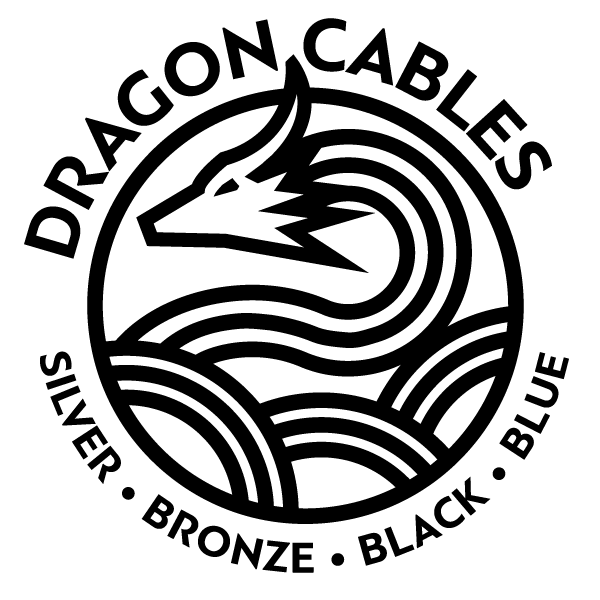
Generally, stock audio cables are manufactured with subpar materials, metals with impurities, poor geometries, and an overabundance of layers to make them look and feel like a fire hose. Inconsistency and lack of quality control in stock cables can lead to poor sound quality and a veiled sound vs. what the musician intended for you to hear and feel from the music. Dragon Audio Cables are handcrafted with the highest standards and made to order according to your specific needs. At Moon Audio, we create a custom cable for you using the highest quality UP-OCC silver or copper conductors that can be manufactured. UP-OCC metals are void of impurities and are optimized for signal transfer and sound quality. We have one of the largest collections of audio and headphone connection options available online and we create limitless audio cable options depending on your specific gear and needs.
Why Dragon Cables?
You’ve heard the saying that a chain is only as strong as its weakest link, right? Well, the same applies to your brand-new audiophile-grade headphone or other audio components. The weakest link, in this case, is your stock audio cable or the cheap interconnects the manufacturer threw in the box just to get you up and running. Why is the audio cable always an afterthought, when it’s just as important as the rest of your system? At Moon Audio, we use the purest and best raw materials in our cables to unveil your music. We believe that materials matter and your audio cables should have the same care and craftsmanship that manufacturers put into their audio components and headphones. Audio cables are ultimately the connection to your music. The fact remains that cabling is often considered the last priority to that of the main product and a means to cut down the overall production costs. It’s as simple as that. Dragon Cables elevate every note - as if you were hearing your favorite music for the very time.
Verdict
Is one DAC better than another? When you're doing your own research, remember that everyone is right and everyone is wrong. There is no perfect answer and it's all subjective. Use YOUR ears to determine what sounds best for YOU - everyone hears differently. Don't use measurement graphs except to get initial impressions. Things like higher bit depths, bit rates, sample rates, lossless formats, and more will make a much larger impact on the quality of your audio data/audio files. Typically speaking standalone DACs or external DACs like the popular Chord Hugo 2, Chord Mojo 2, and iFi Audio Gryphon perform better than built-in DACs or mass-produced off-the-shelf chips, but making sure your DAC is hi-res capable is just as important.
There is no universal approach when it comes to Digital-to-Analog Converters (DACs) because everyone's hearing perception is unique. How a DAC sounds will differ from person to person. The key principle to understand is that an external, standalone, or high-end DAC chip will generally outperform the consumer-level DACs found in most devices. Ultimately, the best DAC for you is the one that sounds good to your ears. Rather than relying solely on specifications, the most important factor is how the DAC's audio output resonates with your personal listening preferences. Listen to different DAC options and choose the one that provides the most enjoyable listening experience for you. By trusting your ears and selecting a DAC that aligns with your sonic preferences, you'll never go wrong, and your music will forever be a source of auditory delight and satisfaction.
A high-quality digital-to-analog converter is truly the heart of any modern audio system, responsible for translating the digital audio data into the analog signals that ultimately drive your speakers or headphones. No matter if it's a tiny portable DAC like the Clarus CODA, a portable music player like the Astell&Kern SR35, or a full-blown high-end standalone DAC like the A15 music server from Aurender, investing in a dedicated, high-performance DAC can breathe new life into your music collection, unveiling intricate details, rich textures, and nuances that you may have never noticed before. With an exceptional DAC at the helm, even familiar albums can sound like you're experiencing them for the very first time, revealing layers of depth and emotion that were previously obscured. Whether you're a discerning audiophile or a passionate music lover, upgrading your DAC is often the single most transformative step you can take to elevate your listening experience and rediscover the magic of your favorite recordings.
Related Videos
We Answer Your FAQs on DACs
FAQs on DACs Ep. 2: Which DAC to Choose?
MUST-HAVE Dongle DACs for Music Lovers
These USB DACs Will Up Your Audio Game
Top Tier Desktop DACs for Diehard Audiophiles
Top 5 Desktop DACs for 2023
Best Portable DACs of 2023
FAQs on DACs
External DACs, or Digital to Analog converters, are an essential part of your audiophile setup. They help process your digital music at a higher level of performance compared to an all-in-one device such as your phone or computer. Most of your electronic devices have built-in DACs already. In a device like your smartphone, which can do a million-and-one things, having to convert your digital signal to analog is an afterthought for many phone manufacturers, and they often include subpar converters. Having a standalone DAC is preferred because that DAC is created to do one thing only: to be the English-to-Spanish translator, or in this case, convert your digital signal to an analog one. That is why external or standalone DACs will always sound better than the factory or stock internal options on most consumer devices.
DACs, fortunately, come in many shapes and sizes. Portable variations are much smaller than their desktop counterparts, but provide just as good performance and either run off an internal battery or USB power if connected to a computer or device. Chord Electronics is a very popular brand that specializes in both portable and desktop digital-to-analog converters. The Chord Mojo is probably one of the best and most versatile options when it comes to portable DACs. iBasso is another great brand that makes portable DACs. There are a number of brands that make some remarkable desktop DAC components. Chord Electronics, Matrix Audio, and Bricasti Design are the top branded DACs that we recommend for home system use. For more buying information on digital-to-analog converters, head over to our “How to Buy A DAC” page.
DAC stands for Digital to Analog Converter. It's a component - in your phone, laptop, tablet, audio device - that processes the digital data of your music and converts it to an analog signal. Once it has been converted to an analog waveform, you can send that to your amplifier and play the music on a speaker or headphones. Think of it as a translator. It's just taking that data and translating it to an analog signal that you can hear.
A DAC is essentially the Google Translate of your audio system. Apart from physical analog media like vinyl and tape, most music today is digital. Just 1s and 0s. And since our ears cannot hear digital data, we need a method of converting these 1s and 0s to an analog format so that it can produce sound waves and thus we are then able to hear it. The digital-to-analog converter does just that: converts the digital data to an analog signal. It takes those 1's and 0's and tracks them to a waveform pattern. To do this, it converts the bits of data from the stored files into an analog electrical signal at thousands of set times per second, called samples. The DAC outputs these samples into a waveform that intersects at all the sample points. However, problems can arise in the conversion process which as we will see later can set some DACs apart from each other. It's an integral part of your system that you can't do without - especially if you have a digital music library.
The basic fact is that our ears are not designed to “hear” data. It's impossible. We can only hear analog signals like sound waves and vibrations, coming from an amplified source through the air. Therefore, we need a device that converts this data into an analog signal. The other factor has to do with the fact that most music today is recorded digitally. This means that the analog signals coming from the instruments and voices being recorded are stored digitally onto computers, mixed and mastered, and then optimized for digital mediums such as compact discs or online streaming and downloading. Analog media, like vinyl and tape, is making a comeback, but still, the majority of music and access to music out there is digital, and ultimately you need something to convert that data before you can hear it.
The quality of the converter chip doesn't necessarily play the biggest role in determining how "good" a DAC is. In fact, the overall audio signal path needs to be considered if we're specifically talking about the "sound quality" of a DAC. That being said, off-the-shelf factory DAC chips - like in your phone - are not very efficient or accurate at converting the data, so the result is a fair presentation of the music, but it leaves much to be desired. A good DAC chip converts the data efficiently and accurately, so that all the information in the data is transmitted to the analog signal. More data points result in a smoother waveform, thus resulting in more natural audio quality. Having multiple DAC chips can also make a difference in the effectiveness of the data conversion that is outputted. Higher-end DAC chipsets are usually Cirrus Logic, ESS, AKM, or Burr-Brown (of course there are others, but these are some of the most popular on the audiophile market). Some DACs themselves - if we're talking about the device alone - might not even use a proper off-the-shelf chipset. Chord DACs use FPGA and their own proprietary algorithms - and they sound phenomenal. This is another reason that you can't simply look at the chipset (or lack thereof) to determine if a DAC is good or not. You have to look at the complete picture, or in this case, the whole audio circuit or architecture from start to finish.
Here at Moon Audio we typically divide DAC types by ergonomic scenario. Do you travel frequently or do you like to listen to your music while on the go? Then perhaps a portable DAC like the Chord Mojo 2 or Clarus CODA would be appropriate for your personal use. USB DACs are a perfect portable option. Do you like to listen to music in the comfort of your home, or perhaps you have a designated space for your sound system? A desktop or tabletop DAC would be a good fit; the Hugo TT 2 is a great option, and the Chord Hugo 2 is a powerful portable DAC that can also serve as a dual-purpose DAC in your home system as well. There are many kinds of DACs for varying usage scenarios, and sometimes audiophiles use multiple types - so they always have good audio quality wherever they are. We could also get into the differences between AKM, ESS, R2R, Burr Brown, Cirrus Logic, and more – but that gets a bit technical and nuanced, so we’ll save that for further down the page.
DACs also come in various configurations, like standalone, or combined with streamers, or servers, and more. You have your Qutest DAC – which is a standalone unit – just the DAC – and our most popular DAC that we sell here at Moon Audio. Next is something like the Bricasti M3, which is a DAC combined with a headphone amplifier. Then you have devices like the Uniti Atom HE, which combines the DAC, a headphone amplifier, and a streamer. And lastly, there is the Aurender A20 – which Is a DAC, Headphone Amp, Streamer, and Server – complete with internal storage for your personal music library.
Absolutely. Without a DAC, your digital data cannot be converted to an analog signal, and thus you won't be able to hear it. Every device you have with a speaker has a built-in DAC. Your phone has a DAC in it. Your AirPods have DACs in them. Your tablet and laptop have DACs in them. Your portable speaker you take to the beach - has a DAC in it.
The more important issue here is: that not all DACs are created equal. We mentioned that the DAC is like the Google Translate of your audio system. It translates the digital data to an analog signal. Are all language translators the same? No - they vary by skill. The same applies to internal factory DACs and external ones. An external DAC is built to do one thing and to do that one thing very well. That is why external DACs that are built for the sole purpose of converting this data are better than factory off-the-shelf converters.
Since the DAC's job is to convert digital data, analog sources do not require a converter. Devices like tape decks and turntables are great examples of gear that read directly from analog mediums (tape and vinyl respectively). The device reads the analog signal in real-time, and then, through the help of an amplifier, transmits that signal to headphones or speakers. It's an easier and more ‘direct’ process than that of the digital world.
You will not need a DAC for your DAP, or Digital Audio Player. Most digital audio players come equipped with a high-end digital-to-analog converter, which is attributed to the premium cost of the device. However, upgrading from a Stereo Receiver to a separate Preamp and Amplifier can elevate the sound performance of the system, and so too can using the DAP as a digital source and adding a higher-performance DAC. For example, if you own the Astell & Kern SR35 you can use it as the digital source with the Chord Hugo 2. The Hugo 2 provides a superior sound over just the SR35 by itself, so pairing the two together would result in better sound, but it's not necessary as the DAP already has a high-end DAC chip in the audio circuit.
It depends on your system. A DAC cannot substitute for an amplifier and an amplifier cannot substitute for a DAC. If your system does not have something to convert the digital data to an analog signal, then you will need a DAC. If your system does not have anything to power your speakers or headphones so that it can amplify the analog signal, then you will need an amplifier. Sometimes there are devices that will have both an amplifier and a DAC like the Matrix Audio Element X2. There are many devices - both portable and desktop - that have both a DAC and an amplifier. A lot of the time we just call these "DAC amps." But if you are without one or the other then you aren't going to hear anything. You need both. If you aren't sure about what you have or what you need, shoot us a call or comment and we'll help you out.
Ooo, tough question. Maybe the better question is, what is the best DAC...for you? There's a lot to consider and each case, each person, will likely have a different answer because - at the end of the day - we all hear differently. And we all have different setups. And we all have different budgets. And on and on. We'll get into proper portable and desktop DAC recommendations in a later video, but keep a few things in mind here when considering what might be the best DAC for you: 1) budget - how much do you wanna spend? 2) ergonomics - where are you going to be listening to music? 3) what is your current audio system? DACs have various I/O (inputs and outputs) options, so picking one that is compatible with your current system is key. 4) What type of sound or sound signature do you prefer? It all depends, and these factors help determine what is the best DAC FOR YOU. It's how we approach our customer service here at Moon Audio - making sure we help you figure out what works best for your specific system, your music, and your ears.

